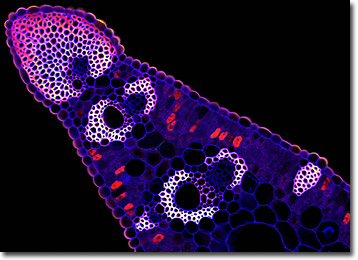 |
 |
 |
|
||||||||||||||||||||||||
 | ||||||||||||||||||||||||
 | ||||||||||||||||||||||||
 | ||||||||||||||||||||||||
Confocal Microscopy Image Gallery
Plant Tissue Autofluorescence Gallery
Cattail Leaf
Cattails comprise the genus Typhus of the family Typhaceae and are closely associated with pond margins, bogs, marshes, and other areas of land where the soil remains inundated throughout the growing season. The tall, narrow plants possess stems that may grow eight feet or more in height, making them readily visible, even from a substantial distance.

Being able to identify cattails can be a great advantage under certain conditions. For instance, the plants almost always signify a body of freshwater, which can serve as a drinking source when necessary, and nearly all of their various components are edible, making them a welcomed sight when food is in short supply.
The pale leaves of cattails are basal, long, and erect. Their ribbon-like form makes them well suited for weaving into items such as baskets, mats, and rope. In cross-section, numerous air channels can be seen in the leaves, which are very spongy and absorbent. Due to this quality, they have at times been used to caulk boats and stop small leaks. The distinctive fuzzy brown fruiting heads of cattails are also useful to humans. The soft material they provide has been employed for a number of different purposes including padding blankets, stuffing pillows, and lining diapers.
Cattails are monoecious plants pollinated by the wind. Both the male and female flowers grow in spikes, with the male spike located above the female spike at the top of the tall cattail stem. After they release their pollen, the male flowers wither so that a small section of naked stem can be seen over the female fruiting spike. The cattail fruit is a small, tufted nutlet that can be easily carried by the wind when the spike bursts.
Additional Confocal Images of Cattail Leaf
Cattail Leaf at High Magnification - Each fruiting cattail flower spike releases 100,000 seeds or more. The pericarp of the fruits opens quickly when exposed to water, and the seeds immediately begin germination under the proper conditions.
Contributing Authors
Nathan S. Claxton, Shannon H. Neaves, and Michael W. Davidson - National High Magnetic Field Laboratory, 1800 East Paul Dirac Dr., The Florida State University, Tallahassee, Florida, 32310.
